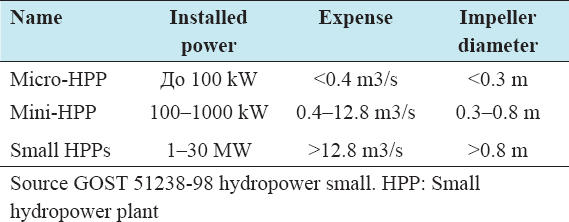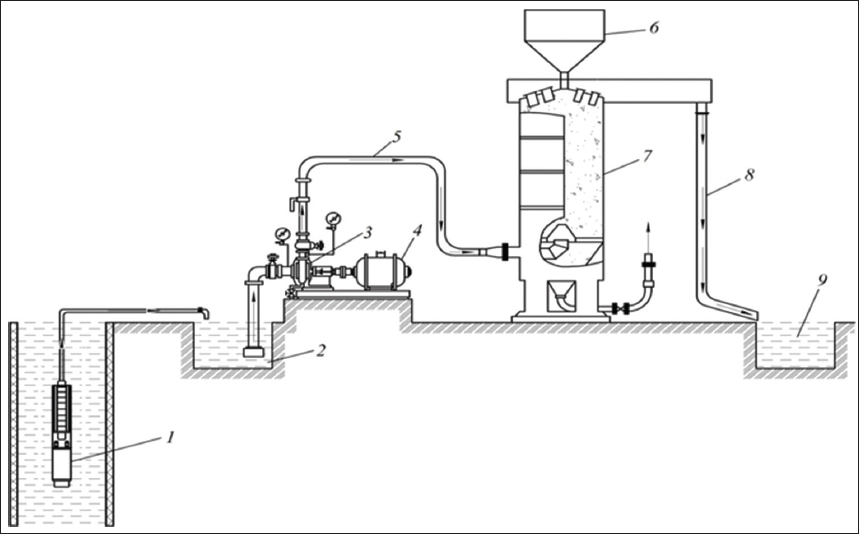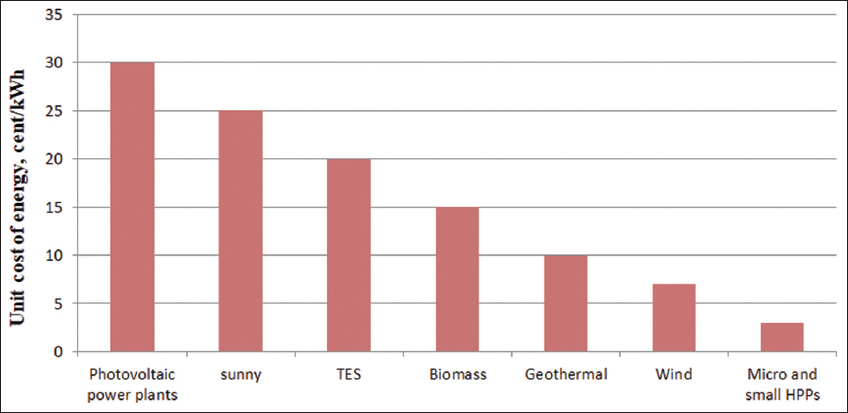RESULTS AND DISCUSSION
Among the most effective and promising directions of alternative energy development is the way of using own energy of water movement, or rather water flow, using electric generators.
At mining enterprises of Uzbekistan, in particular at Navoi Mining and Metallurgical Combine, there is a huge potential for application of micro and small HPPs. In particular, at geotechnological mines, there are local sorption units (LSU) [Figure 1].
Figure :1 Core technological scheme of the local sorption plant. (1) Drain pipeline, (2) technological map (rich solution), (3) pump, (4) electric motor, (5) pipeline, (6) hopper, (7) tank, (8) pipeline, (9) technological map (poor solution)
During the operation of LSU (local sorption unit) on the pipeline (8) installed between the tank (7) and the process card (9), a liquid with a volume of 85 l/s flows by gravity, which can be converted to usable energy using a micro HPP (hydroelectric power plant).
Useful transformation of liquid flow energy in LSU units allows to reduce the cost of electric energy during the operation of drainage and auxiliary units on geotechnological fields of the mine.
It should be noted that hydroelectric power plants can be installed practically on any watercourses: From small streams to the largest rivers. The capacity of their hydroelectric units changes accordingly. At present, the following classification is adopted: Stations with capacity of 100 kW – micro-HPP, from 100 about 1000 kW – mini-HPP, from 1000 about 10,000 kW – small HPP, and over 10,000 kW – large hydroelectric power plants. The design and construction principles of these classes of power plants may differ significantly.[2]
Micro-HPPs are distinguished by a great variety of design versions. They can be built, as well as more powerful plants, using a pressure pipeline or channel. Finally, micro-HPPs can be installed in a river stream without any hydraulic structures – free flow micro-HPPs.
The generator is the most important element of electrical equipment of autonomous electric installation. In addition to the main purpose, which is the generation of electrical energy, the generator must perform certain functions to stabilize or regulate the parameters that characterize its quality. Therefore, one of the requirements to the generator of autonomous electric installation is controllability. The design of the generator should provide the possibility of its operation in the open air with a high degree of reliability for a long time.
Micro-HPP units mainly use alternators of synchronous or asynchronous types. The advantages of asynchronous generators are high reliability, small size, low cost, and ease of switching on for parallel operation. Their main disadvantages include the need for a capacitor bank for self-excitation and the relative complexity of regulation of the output voltage.
Figure 2 shows the specific cost of energy when it is obtained by various methods. From the histogram, it is observed that the use of micro and small HPPs allows to obtain electricity with the lowest cost.
Figure :2 Histogram of specific cost of energy in obtaining them by different methods
From the above histograms, we can see that for the use of RES where the least consumption is required are micro and small HPPs.
At mining enterprises of Uzbekistan, in particular at enterprises of Navoi region, there is huge potential for application of micro and small HPPs. Production enterprises have technological schemes, where there are liquid flows through pipelines by gravity flow, which can be useful to convert into electrical energy with the help of electric generators.




